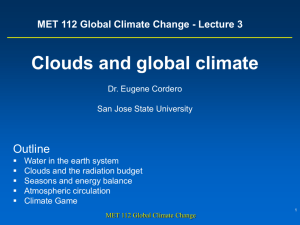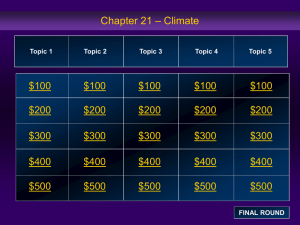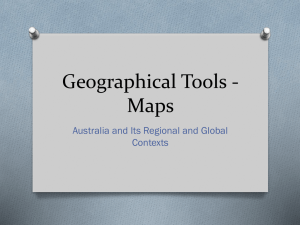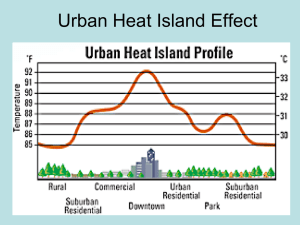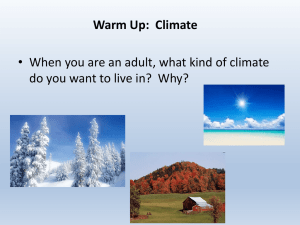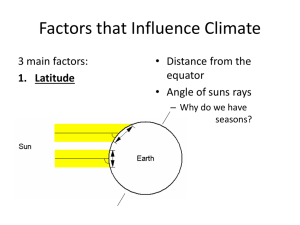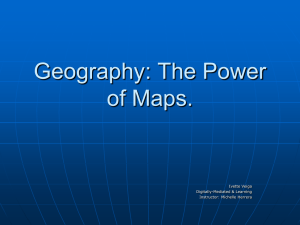Met112lecture4 - San Jose State University
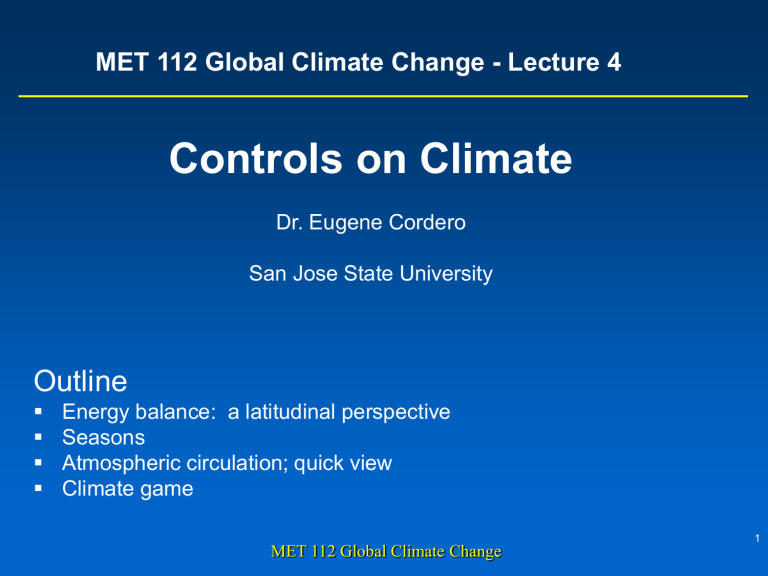
MET 112 Global Climate Change - Lecture 4
Controls on Climate
Dr. Eugene Cordero
San Jose State University
Outline
Energy balance: a latitudinal perspective
Seasons
Atmospheric circulation; quick view
Climate game
MET 112 Global Climate Change
1
Definitions
Insolation – Incoming solar radiation
Solstice – day of the year when the sun shines directly over 23.5
°S or 23.5°N
Equinox – days of the year when the sun shines directly over the equator
MET 112 Global Climate Change
3
Sun angle
MET 112 Global Climate Change
5
Sun angle (2)
MET 112 Global Climate Change
6
What influences incoming solar energy?
The Sun’s angle of incidence:
– Lower sun angle, less incoming energy
– Higher sun angle, more incoming energy
Length of time the Sun shines each day:
– Summer season, more sun hours
– Winter season, less sun hours
MET 112 Global Climate Change
9
Why do we have seasons?
MET 112 Global Climate Change
10
What month do you think this graph represents?
a) December b) March c) June d) September
MET 112 Global Climate Change
11
What month do you think this graph represents?
0 of 70
1. December
2. March
3. June
4. September
0% 0% 0% 0%
D ec em be r
MET 112 Global Climate Change
M ar ch
S ep te m be r
Ju ne
12
Review questions
On June 21 st , at what latitude is the sun directly overhead at noon?
On September 22 nd , at what latitude is the sun directly overhead at noon?
How many hours of daylight are present at the
South Pole on February 20 th ?
Where would you expect to have longer days;
45 ° N on June 21 st or 50 °S on Dec 21 st ?
MET 112 Global Climate Change
14
On June 21 st , at what latitude is the sun directly overhead at noon?
1. Equator (0)
2. 23.5
°N
3. 23.5
°S
4. 90 °N (north pole)
5. 90 °S (south pole)
0 of 70
0% 0% 0% 0% 0%
E qu at or
(0
)
MET 112 Global Climate Change
23
.5
°N
23
.5
°S
90
°N
(n or th
p ol e)
90
°S
(s ou th
p ol e)
16
Where would you expect to have longer days;
45 ° N on June 21 st or 50 °S on Dec 21 st ?
1. 45 °N
2. 50 °S
3. They are the same
4. Impossible to tell
0 of 70
0% 0% 0% 0%
C ho ic e
O ne
MET 112 Global Climate Change
C ho ic e
Tw o
C ho ic e
Th re e
C ho ic e
Fo ur
17
On September 22 nd , at what latitude is the sun directly overhead at noon?
1. Equator (0)
2. 23.5
°N
3. 23.5
°S
4. 90 °N (north pole)
5. 90 °S (south pole)
0 of 70
0% 0% 0% 0% 0%
E qu at or
(0
)
MET 112 Global Climate Change
23
.5
°N
23
.5
°S
90
°N
(n or th
p ol e)
90
°S
(s ou th
p ol e)
18
How many hours of daylight are present at the South Pole on February 20 th ?
1. 0 hours
2. 6 hours
3. 12 hours
4. 18 hours
5. 24 hours
0 of 70
0% 0% 0% 0% 0%
0 ho ur s
MET 112 Global Climate Change
6 ho ur s
12
h ou rs
18
h ou rs
24
h ou rs
19
MET 112 Global Climate Change
20
Earth’s energy: latitudinal perspective
A majority of the sun’s energy enters the Earth system in the tropics.
The tropics thus becomes quite warm, while the poles relatively cool.
The atmosphere attempts to bring the tropics and high latitude into equilibrium
– Weather systems ultimately act to bring warm air to higher latitudes and cold air to lower latitudes.
MET 112 Global Climate Change
22
Annual Surface Temperature
Questions
Indicate the warmest and coldest areas of the
Earth.
Consider the temperature at 60N latitude.
Indicate on the map the coldest and warmest places at 60N.
What is the temperature difference between these locations
What factors might explain this temperature difference?
Why is there not a similar difference seen at 60S?
MET 112 Global Climate Change
24
Annual Surface Temperature
MET 112 Global Climate Change
25
Climate controls:
Latitude/Mountains
Latitude
– Higher latitude climates are generally
(cooler/warmer)
– Lower latitudes climates are generally
(cooler/warmer)
Mountains
– Higher altitudes climate are generally
(cooler/warmer): cooler temperatures
– Windward side of mountains are generally
(cooler/warmer) and (wetter/drier), than leeward side
MET 112 Global Climate Change
26
Climate controls:
Latitude/Mountains
Latitude
– Higher latitude climates are generally
(cooler/warmer)
– Lower latitudes climates are generally
(cooler/warmer)
Mountains
– Higher altitudes climate are generally
(cooler/warmer): cooler temperatures
– Windward side of mountains are generally
(cooler/warmer) and (wetter/drier), than leeward side
MET 112 Global Climate Change
27
Controls on Climate
Seasonal temperature and precipitation patters are generally attributable to:
Latitude
Mountains and highlands
Land and water location
Prevailing winds
Pressure and wind systems
Ocean currents
MET 112 Global Climate Change
28
MET 112 Global Climate Change
29
Controls on Climate: Oceans
Ocean Temperatures
– Coasts of continents are affected by ocean temperatures: Generally less temperature extremes compared to interior of continents
– Cold oceans: generally produce cooler/drier conditions
– Warm oceans: generally produce more warm/humid conditions
31
MET 112 Global Climate Change
MET 112 Global Climate Change
32
Cold ocean
Warm ocean
MET 112 Global Climate Change
33
MET 112 Global Climate Change
34
Dry
Humid
MET 112 Global Climate Change
35
Controls on Climate: Pressure systems
Rising and sinking motion associated with low and high pressure affects climate
Areas where pressure seasonally low,
–
Tropics: rainy
Areas where pressure seasonally high,
–
Subtropical high (30N/3OS): warm and dry
MET 112 Global Climate Change
37
January Average sea-level Pressure and surface wind pattern
MET 112 Global Climate Change
38
July Average sea-level Pressure and surface wind pattern
MET 112 Global Climate Change
39
MET 112 Global Climate Change
40
A_B_D_ let’s check out clicker id’s out
1. E Q U
2. I E B
3. E L O
4. O U W
0 of 70
0% 0% 0% 0%
E
Q
U
MET 112 Global Climate Change
I E
B
E
L
O
O
U
W
41
Climate Game
Names ___________________________
Match the city with the corresponding climatology by indicating the appropriate letter
Sacramento, California (38 °N) _____________
Phoenix, Arizona (33 °N) _____________
Denver, Colorado (40 °N) _____________
Iquitos, Peru (4 °S)
Mobile, Alabama (30 °N)
Winnipeg, Canada (50 °N)
Fairbanks, Alaska (65 °N)
_____________
_____________
_____________
_____________
City A
1. Sacramento, California
2. Phoenix, Arizona
3. Denver, Colorado
67%
4. Iquitos, Peru
5. Mobile, Alabama
14%
6. Winnipeg, Canada
7% 7%
0%
2% 2%
7. Fairbanks, Alaska
S ac ra m en to
, C al ifo
P rn ia rizo ho en ix
, A
D en ve r, na
C ol or ad o
Iq ui to s,
P er u
M ob ile
, A la
W in ni ba m a pe g,
C an ad a
Fa irb an ks
, A la sk a
MET 112 Global Climate Change
43
City B
1. Sacramento, California
2. Phoenix, Arizona
3. Denver, Colorado
72%
4. Iquitos, Peru
5. Mobile, Alabama
6. Winnipeg, Canada 14%
12%
0%
2%
0% 0% 7. Fairbanks, Alaska
S ac ra m en to
, C al ifo
P rn ia rizo ho en ix
, A
D en ve r, na
C ol or ad o
Iq ui to s,
P er u
M ob ile
, A la
W in ni ba m a pe g,
C an ad a
Fa irb an ks
, A la sk a
MET 112 Global Climate Change
44
City C
1. Sacramento, California
2. Phoenix, Arizona
3. Denver, Colorado
67%
4. Iquitos, Peru
5. Mobile, Alabama
19%
6. Winnipeg, Canada
7%
5%
0%
2%
0% 7. Fairbanks, Alaska
S ac ra m en to
, C al ifo
P rn ia rizo ho en ix
, A
D en ve r, na
C ol or ad o
Iq ui to s,
P er u
M ob ile
, A la
W in ni ba m a pe g,
C an ad a
Fa irb an ks
, A la sk a
MET 112 Global Climate Change
45
City D
1. Sacramento, California
2. Phoenix, Arizona
3. Denver, Colorado
84%
4. Iquitos, Peru
5. Mobile, Alabama
6. Winnipeg, Canada
9%
4%
0% 0% 0%
2%
7. Fairbanks, Alaska
S ac ra m en to
, C al ifo
P rn ia rizo ho en ix
, A
D en ve r, na
C ol or ad o
Iq ui to s,
P er u
M ob ile
, A la
W in ni ba m a pe g,
C an ad a
Fa irb an ks
, A la sk a
MET 112 Global Climate Change
46
City E
1. Sacramento, California
2. Phoenix, Arizona
3. Denver, Colorado
47%
4. Iquitos, Peru
20%
5. Mobile, Alabama
13%
9% 6. Winnipeg, Canada
7%
4%
0% 7. Fairbanks, Alaska
S ac ra m en to
, C al ifo
P rn ia rizo ho en ix
, A
D en ve r, na
C ol or ad o
Iq ui to s,
P er u
M ob ile
, A la
W in ni ba m a pe g,
C an ad a
Fa irb an ks
, A la sk a
MET 112 Global Climate Change
47
City F
1. Sacramento, California
2. Phoenix, Arizona
3. Denver, Colorado
83%
4. Iquitos, Peru
5. Mobile, Alabama
6. Winnipeg, Canada
5% 5% 5%
0%
2%
0% 7. Fairbanks, Alaska
S ac ra m en to
, C al ifo
P rn ia rizo ho en ix
, A
D en ve r, na
C ol or ad o
Iq ui to s,
P er u
M ob ile
, A la
W in ni ba m a pe g,
C an ad a
Fa irb an ks
, A la sk a
MET 112 Global Climate Change
48

